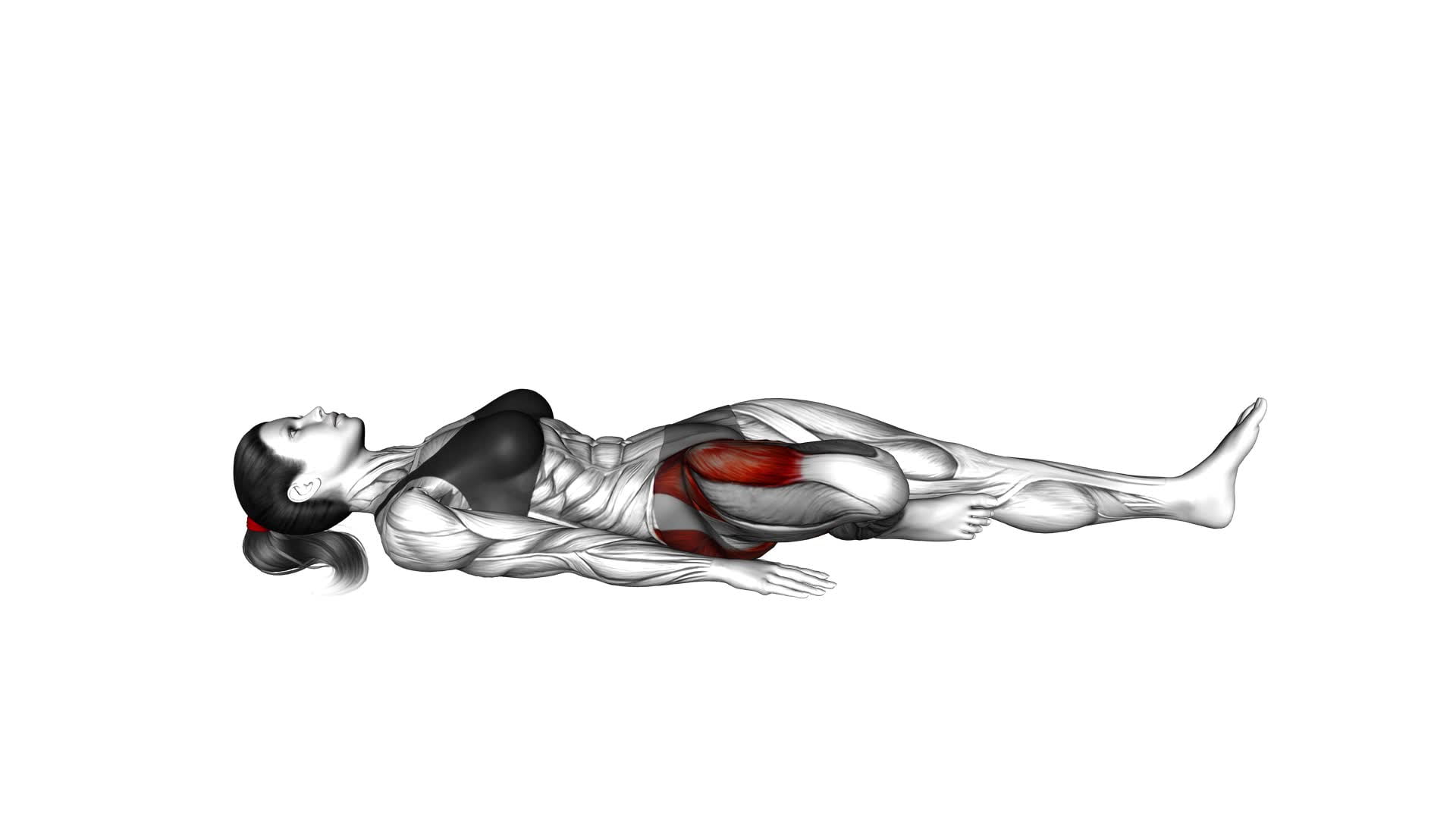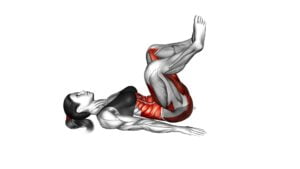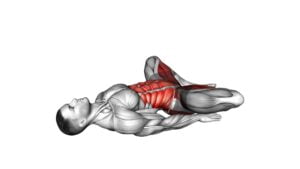Lying Single Leg Butterfly (female) – Video Exercise Guide & Tips

Are you looking for a challenging lower body exercise that targets your hips and inner thighs? Look no further than the lying single leg butterfly.
Watch This Exercise Video
In this video exercise guide, we'll show you how to properly set up for the exercise and provide step-by-step instructions on how to perform it.
Plus, we'll share tips for maintaining proper form and technique, as well as modifications for all fitness levels.
Get ready to strengthen and tone your lower body with this effective exercise.
Key Takeaways
- The Lying Single Leg Butterfly exercise targets multiple muscles in the body, including the inner thigh muscles.
- Engaging the core muscles is crucial for stabilization during this exercise.
- This exercise improves hip mobility and flexibility while strengthening the glutes and hamstrings.
- It is an effective exercise for women looking to tone and strengthen their lower body.
Benefits of the Lying Single Leg Butterfly Exercise
The lying single leg butterfly exercise provides numerous benefits for women. This exercise, which involves lying on your back with one leg bent and the other extended out to the side, targets multiple muscles in the body.
One of the primary muscles targeted in the lying single leg butterfly is the inner thigh muscles, also known as the adductors. These muscles are responsible for bringing the legs together and are often underutilized in traditional exercises.
By performing variations of the lying single leg butterfly exercise, you can also engage the core muscles, including the abdominals and obliques, as they work to stabilize the body during the movement.
Additionally, this exercise can help improve hip mobility and flexibility, as well as strengthen the glutes and hamstrings.
Now that you understand the benefits of the lying single leg butterfly exercise, let's move on to how to properly set up for the exercise.
How to Properly Set Up for the Exercise
To properly set up for the lying single leg butterfly exercise, it's important to focus on proper alignment and positioning. Make sure your back is flat against the ground and your legs are bent with the soles of your feet touching.
You'll also need a mat or towel for comfort. Additionally, you can modify the exercise by using a cushion or block under your hips if needed.
Proper Alignment for Exercise
Ensure proper alignment for the exercise by positioning your body correctly. Proper alignment is crucial to maximize the effectiveness of the lying single leg butterfly exercise.
To achieve the correct alignment, start by lying flat on your back with your legs extended. Bend one knee and place the sole of your foot against the opposite inner thigh. Your other leg should remain extended on the ground. Keep your spine neutral, with your lower back pressed gently into the floor.
Avoid common alignment mistakes such as rounding your shoulders or arching your lower back. Instead, focus on maintaining a stable and aligned posture throughout the exercise. Pay attention to alignment cues, such as engaging your core and lengthening your spine, to ensure proper form and prevent injury.
Necessary Equipment and Modifications
To properly set up for the lying single leg butterfly exercise, you'll need a yoga mat or comfortable surface to lie on. This exercise doesn't require any additional equipment, making it accessible for everyone.
However, if you have any specific modifications or variations you'd like to incorporate, you may need additional props such as blocks or straps. These can help provide support or assist in achieving proper alignment during the exercise.
It's important to listen to your body and make any necessary modifications based on your individual abilities and limitations. Remember, the goal is to engage the muscles and stretch the hips, so feel free to explore different variations and alternatives to find what works best for you.
The benefits of the lying single leg butterfly exercise include increased hip mobility, improved posture, and reduced lower back pain.
Step-by-Step Guide to Performing the Lying Single Leg Butterfly
Lie on your back and bend one leg, bringing the sole of your foot to rest against the opposite inner thigh. This is the starting position for the lying single leg butterfly exercise. To perform the exercise, gently press your knee towards the floor and then return to the starting position. Repeat this movement for the desired number of repetitions.
The lying single leg butterfly primarily targets the hip adductor muscles, which are responsible for bringing the legs together. These muscles include the adductor magnus, adductor longus, adductor brevis, and gracilis. By performing this exercise, you can strengthen and tone these muscles, improving your overall lower body strength and stability.
There are variations of the lying single leg butterfly exercise that you can incorporate into your routine to add variety and challenge. One variation is the weighted lying single leg butterfly, where you hold a dumbbell or a weighted plate on your thigh while performing the exercise. This adds resistance and increases the intensity of the exercise, making it more challenging and effective for muscle development.
Remember to always listen to your body and stop if you experience any pain or discomfort. It's important to maintain proper form throughout the exercise to avoid any unnecessary strain or injury.
Incorporating the lying single leg butterfly into your workout routine can help you strengthen and tone your hip adductor muscles for improved lower body strength and stability.
Tips for Proper Form and Technique
Maintain proper alignment and engage your core while performing the lying single leg butterfly exercise. These tips will help you ensure proper form and technique throughout the exercise.
One common mistake is letting your lower back lift off the floor. To avoid this, press your lower back firmly into the ground throughout the movement. This will engage your core and protect your lower back from strain.
Another mistake is allowing your knee to drop to the side instead of keeping it in line with your hip. To maintain proper form, focus on keeping your knee directly above your hip throughout the exercise.
If you find it difficult to keep your leg straight, you can modify the exercise by bending your knee slightly. This variation will reduce the tension on your hamstring and make the exercise more accessible.
To increase the challenge, you can try adding resistance by placing a small exercise ball or a folded towel between your knee and your inner thigh. This will engage your inner thigh muscles and add an extra element of difficulty to the exercise.
Remember to listen to your body and adjust the exercise as needed. By maintaining proper form and technique, you'll maximize the benefits of the lying single leg butterfly exercise.
Modifications and Progressions for All Fitness Levels
As you progress in your fitness journey, there are various modifications and progressions you can incorporate into the lying single leg butterfly exercise to challenge yourself and continue to improve. Here are some options to consider:
- Increase the range of motion: Start by placing a yoga block or folded towel under your sacrum to elevate your hips. This will allow for a deeper stretch in the hips and groin muscles.
- Add resistance: Place a resistance band around your thighs, just above the knees, and press against it as you perform the exercise. This will engage your outer hip muscles and add an extra challenge to the movement.
- Incorporate balance challenges: Lift your arms off the ground and extend them overhead, or try performing the exercise on an unstable surface like a balance cushion or foam pad. This will require additional core stability and improve your balance.
By incorporating these progression modifications into your lying single leg butterfly exercise, you can take it to the next level and continue to challenge your body.
Now, let's move on to the next section where we'll discuss common mistakes to avoid during the lying single leg butterfly.
Common Mistakes to Avoid During the Lying Single Leg Butterfly
To maximize the effectiveness of your lying single leg butterfly exercise, it's important to be aware of and avoid common mistakes that can hinder your progress. By avoiding these mistakes, you can ensure that you're performing the exercise correctly and safely, reducing the risk of injuries.
One common mistake to avoid is forcing your leg into a position it's not ready for. Many people try to push their leg down too far, causing strain on the hip and groin muscles. Instead, focus on gently stretching and gradually increasing the range of motion over time.
Another mistake to avoid is rounding your back during the exercise. This can put unnecessary strain on your spine and lead to discomfort or injury. Keep your back flat against the ground and engage your core muscles to maintain proper alignment throughout the movement.
A common misconception is that the exercise should be painful. While you may feel a stretch in your hip and groin area, it should never be painful. If you experience any pain, stop the exercise and consult with a fitness professional or healthcare provider.
Frequently Asked Questions
How Many Calories Does the Lying Single Leg Butterfly Exercise Burn?
The lying single leg butterfly exercise is a great way to burn calories and improve your hip flexibility. By engaging your core and lower body muscles, you can expect to burn a significant amount of calories during this exercise.
Incorporating this exercise into your routine can help you achieve your fitness goals and increase your overall strength and flexibility.
Can the Lying Single Leg Butterfly Exercise Help Improve Flexibility in the Hips?
The lying single leg butterfly exercise can improve flexibility in your hips. By incorporating this exercise into your routine, you can experience the benefits of increased hip flexibility.
It's important to note that there are modifications available for the lying single leg butterfly exercise to cater to different fitness levels and goals. So, whether you're a beginner or advanced, this exercise can help you target and improve the flexibility of your hips.
Is the Lying Single Leg Butterfly Exercise Suitable for Individuals With Knee Injuries?
The lying single leg butterfly exercise can be modified to suit individuals with knee injuries. By modifying the exercise, you can still benefit from the lying single leg butterfly's ability to improve flexibility in the hips. This exercise can also help strengthen your overall leg muscles, providing a well-rounded workout for your lower body.
It's important to prioritize your safety and consult with a healthcare professional before attempting any exercises.
Can the Lying Single Leg Butterfly Exercise Help Alleviate Lower Back Pain?
The lying single leg butterfly exercise can be beneficial in alleviating lower back pain. By engaging your core and stretching your hip muscles, it helps to improve flexibility and strengthen your lower back.
There are also variations of this exercise that you can try, such as using a resistance band or adding a twist. Incorporating these variations can provide additional benefits and target different muscle groups.
How Often Should the Lying Single Leg Butterfly Exercise Be Performed for Optimal Results?
To achieve optimal results with the lying single leg butterfly exercise, it's important to incorporate variations and perform it regularly. By consistently engaging in this exercise, you can improve flexibility and strengthen your lower body muscles.
However, the frequency of performing the exercise will depend on your fitness level and goals. Consulting with a fitness professional can help determine the ideal frequency for you.
Conclusion
In conclusion, the lying single leg butterfly exercise is a beneficial exercise for improving lower body strength and flexibility. By properly setting up and following the step-by-step guide, individuals can perform this exercise with proper form and technique.
Additionally, modifications and progressions are available for individuals of all fitness levels. It's important to avoid common mistakes to maximize the effectiveness of this exercise.
Incorporating the lying single leg butterfly into your fitness routine can help you achieve your fitness goals.

Author
Years ago, the spark of my life’s passion ignited in my mind the moment I stepped into the local gym for the first time. The inaugural bead of perspiration, the initial endeavor, the very first surge of endorphins, and a sense of pride that washed over me post-workout marked the beginning of my deep-seated interest in strength sports, fitness, and sports nutrition. This very curiosity blossomed rapidly into a profound fascination, propelling me to earn a Master’s degree in Physical Education from the Academy of Physical Education in Krakow, followed by a Sports Manager diploma from the Jagiellonian University. My journey of growth led me to gain more specialized qualifications, such as being a certified personal trainer with a focus on sports dietetics, a lifeguard, and an instructor for wellness and corrective gymnastics. Theoretical knowledge paired seamlessly with practical experience, reinforcing my belief that the transformation of individuals under my guidance was also a reflection of my personal growth. This belief holds true even today. Each day, I strive to push the boundaries and explore new realms. These realms gently elevate me to greater heights. The unique combination of passion for my field and the continuous quest for growth fuels my drive to break new ground.



